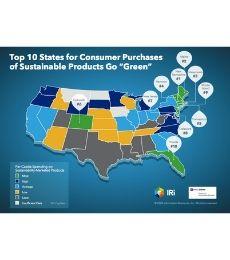Research Highlights
Latest Research From NYU Stern Center for Sustainable Business and IRI Shows That Sustainability Is Surviving COVID-19
—

Results from the 2020 CSB Sustainable Market Share Index™ examine trends and consumer demographics for sustainable products and highlight the impact of COVID-19 on sustainable CPG brands
The NYU Stern Center for Sustainable Business and IRI® are following up their seminal 2019 analysis, the CSB Sustainable Market Share Index™, with new research examining consumer purchases of sustainability-marketed consumer packaged goods and taking a closer look at the top 10 states in terms of per capita spending on sustainability-marketed products. Results from the latest research, released today, include:
“Our ongoing partnership with IRI continues to yield exciting results — now a ‘must-see update’ for CPG marketers,” said Randi Kronthal-Sacco, senior scholar, Marketing and Corporate Outreach, Stern’s Center for Sustainable Business, who led the research initiative. “Our analysis demonstrates that sustainability-marketed products enjoy a hefty premium, continue to grow faster than their conventional counterparts and contribute to over half of the growth to overall CPG. It’s clear that brand managers who are not pursuing sustainability strategies will be increasingly left behind.”
“Sustainability-marketed products are a key to winning with millennials and Generation Z,” said Larry Levin, executive vice president, Market and Shopper Intelligence, IRI. “Leveraging the goodness of your company with compelling brand stories is an opportunity to build long-standing relationships with these important segments. In fact, the recently launched IRI New Product Pacesetters™ included three of the top- 10 food and beverages and two of the top 10 non-foods as products that had sustainability positioning to win in the initial launch year. It’s a real testimony to see manufacturers recognizing consumer desires for sustainable products and consumers responding by driving these products to New Product Pacesetter status.”
Contacts:
Carolyn Ritter and Jeff Piascik, NYU Stern Public Affairs
212-998-0624, critter@stern.nyu.edu
212-998-0906, jpiascik@stern.nyu.edu
Shelley Hughes, IRI
312-474-3675, shelley.hughes@iriworldwide.com
- COVID-19 findings
- During a period of record CPG growth, sustainability-marketed products continued to grow with 16.8% dollar market share YTD, up 0.6 ppts vs. 2019.
- During the week ending March 15, 2020, when CPG sales peaked due to COVID-19, sustainability-marketed products experienced a +1.9 ppts share increase (vs. the prior week), and dollar sales increased 56% during that same period. The categories that experienced the greatest share growth in sustainability-marketed purchases that week were paper products, weight control products, coffee and soap.
- Market growth findings
- From 2015 to 2019, sustainability-marketed products contributed 54.7% of overall CPG market growth while representing 16.1% dollar share of the category in 2019
- Pricing findings (analysis excludes store brands)
- On average, across 35 CPG categories examined, sustainability-marketed products enjoyed a sizable premium of 39% over conventionally marketed products, with their price premium widening since 2014.
- Notwithstanding the high premiums, sustainability-marketed products grew over seven times faster than conventional products, demonstrating consumers’ strong preference for these products and their willingness to pay higher prices.
- Demographic and geographic findings
- Consumers in upper incomes and with higher levels of education are more likely to buy sustainability-marketed products than other groups.
- Millennials are more likely to buy sustainability-marketed products. However, most sustainable purchases are attributed to Generation X and baby boomers due to the size of their cohorts.
- The top 10 states in terms of per capita spending on sustainability-marketed products are New Hampshire, Maine, Massachusetts, Vermont, Connecticut, Colorado, New Jersey, Delaware, Rhode Island and Florida. Measured by state-wide purchases, however, California, Florida, Texas and New York top the rankings.
- The bottom five states in terms of per capita spending on sustainability-marketed products are Mississippi, Utah, Kentucky, Alabama and Texas.
“Our ongoing partnership with IRI continues to yield exciting results — now a ‘must-see update’ for CPG marketers,” said Randi Kronthal-Sacco, senior scholar, Marketing and Corporate Outreach, Stern’s Center for Sustainable Business, who led the research initiative. “Our analysis demonstrates that sustainability-marketed products enjoy a hefty premium, continue to grow faster than their conventional counterparts and contribute to over half of the growth to overall CPG. It’s clear that brand managers who are not pursuing sustainability strategies will be increasingly left behind.”
“Sustainability-marketed products are a key to winning with millennials and Generation Z,” said Larry Levin, executive vice president, Market and Shopper Intelligence, IRI. “Leveraging the goodness of your company with compelling brand stories is an opportunity to build long-standing relationships with these important segments. In fact, the recently launched IRI New Product Pacesetters™ included three of the top- 10 food and beverages and two of the top 10 non-foods as products that had sustainability positioning to win in the initial launch year. It’s a real testimony to see manufacturers recognizing consumer desires for sustainable products and consumers responding by driving these products to New Product Pacesetter status.”
Contacts:
Carolyn Ritter and Jeff Piascik, NYU Stern Public Affairs
212-998-0624, critter@stern.nyu.edu
212-998-0906, jpiascik@stern.nyu.edu
Shelley Hughes, IRI
312-474-3675, shelley.hughes@iriworldwide.com
